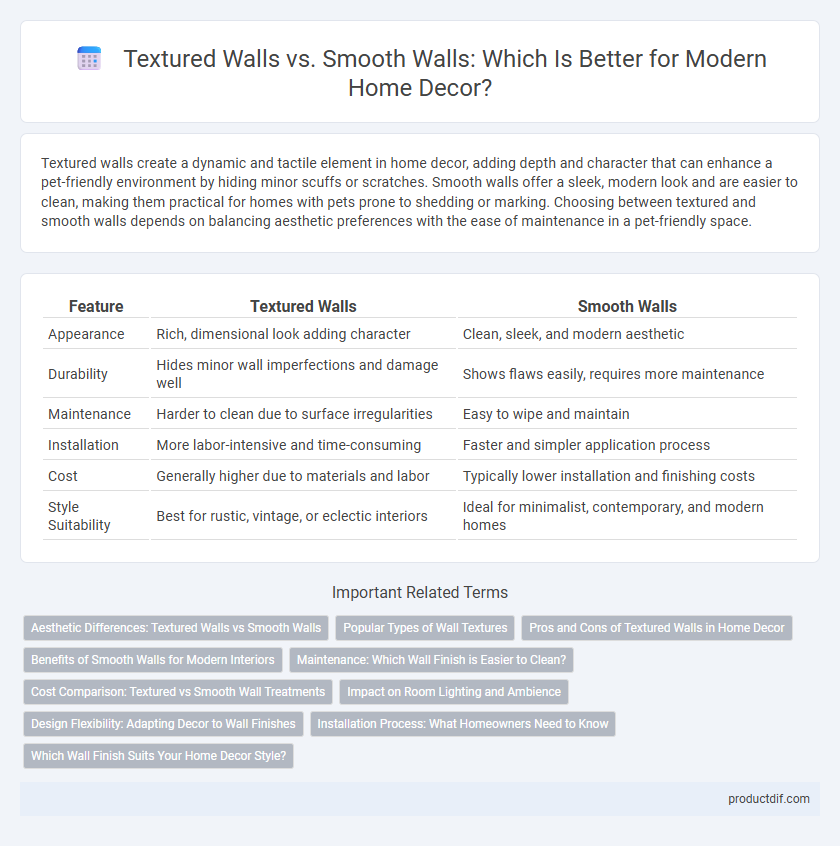Textured walls create a dynamic and tactile element in home decor, adding depth and character that can enhance a pet-friendly environment by hiding minor scuffs or scratches. Smooth walls offer a sleek, modern look and are easier to clean, making them practical for homes with pets prone to shedding or marking. Choosing between textured and smooth walls depends on balancing aesthetic preferences with the ease of maintenance in a pet-friendly space.
Table of Comparison
| Feature | Textured Walls | Smooth Walls |
|---|---|---|
| Appearance | Rich, dimensional look adding character | Clean, sleek, and modern aesthetic |
| Durability | Hides minor wall imperfections and damage well | Shows flaws easily, requires more maintenance |
| Maintenance | Harder to clean due to surface irregularities | Easy to wipe and maintain |
| Installation | More labor-intensive and time-consuming | Faster and simpler application process |
| Cost | Generally higher due to materials and labor | Typically lower installation and finishing costs |
| Style Suitability | Best for rustic, vintage, or eclectic interiors | Ideal for minimalist, contemporary, and modern homes |
Aesthetic Differences: Textured Walls vs Smooth Walls
Textured walls add depth and visual interest, creating a dynamic and tactile surface that enhances rustic, industrial, or eclectic home decor styles. Smooth walls offer a clean, minimalist aesthetic that highlights colors and artwork, providing a sleek, modern backdrop ideal for contemporary and Scandinavian interiors. The choice between textured and smooth walls significantly affects the room's ambiance, influencing light reflection and the perceived spatial dimensions.
Popular Types of Wall Textures
Popular types of wall textures include knockdown, orange peel, and skip trowel, each offering distinct visual depth and tactile interest to home interiors. Knockdown texture features a flattened, mottled surface achieved by spraying and then lightly smearing joint compound, ideal for hiding imperfections. Orange peel texture resembles the skin of an orange with fine bumps, providing subtle dimension while skip trowel imparts a more pronounced, rustic finish through a random trowel application, making textured walls a versatile alternative to smooth finishes.
Pros and Cons of Textured Walls in Home Decor
Textured walls add depth and visual interest, enhancing the character of living spaces while effectively hiding imperfections such as cracks and uneven surfaces. They offer durability and conceal dirt better than smooth walls but can be challenging to clean and may limit options for future wall treatments like wallpaper or paint finishes. Smooth walls provide a sleek, modern look and allow easier maintenance and decorating flexibility, but they tend to showcase flaws more prominently.
Benefits of Smooth Walls for Modern Interiors
Smooth walls enhance modern interiors by providing a clean, minimalist backdrop that accentuates furniture and decor elements. They facilitate easier maintenance and painting, ensuring a fresh, polished look with minimal effort. The uniform surface also improves lighting distribution, creating a brighter and more spacious ambiance.
Maintenance: Which Wall Finish is Easier to Clean?
Smooth walls are generally easier to clean than textured walls because their flat surfaces allow for quick dusting and wiping without trapping dirt or grime. Textured walls tend to collect dust and debris within crevices, requiring more effort and specialized tools or cleaning agents to maintain their appearance. Choosing smooth wall finishes can significantly reduce cleaning time and maintenance efforts in home decor.
Cost Comparison: Textured vs Smooth Wall Treatments
Textured walls generally incur higher costs due to additional materials and labor needed for application compared to smooth walls, which require less preparation and finish work. Smooth wall treatments typically involve simpler painting or wallpapering processes, lowering initial expenses and maintenance over time. Budget considerations often favor smooth walls for cost-effectiveness, while textured walls offer unique aesthetic value with a premium price tag.
Impact on Room Lighting and Ambience
Textured walls diffuse light, creating soft shadows that add depth and warmth to a room's ambience, enhancing visual interest without harsh glare. Smooth walls reflect light uniformly, resulting in a brighter, more open feel that highlights room colors and decor elements with clarity. Choosing between textured and smooth walls directly influences how natural and artificial lighting interact with the space, impacting mood and spatial perception.
Design Flexibility: Adapting Decor to Wall Finishes
Textured walls offer unique depth and visual interest, allowing for bold, rustic, or eclectic decor styles that emphasize natural elements or artistic accents. Smooth walls provide a versatile backdrop, supporting minimalist or contemporary designs with easy adaptability for various color schemes and accessories. Selecting between textured and smooth finishes directly influences furniture choices, lighting effects, and overall ambiance tailored to the room's purpose and aesthetic.
Installation Process: What Homeowners Need to Know
Textured walls require additional preparation including priming and applying a base coat before using specialized tools like trowels or brushes for creating patterns, which generally extends installation time and complexity compared to smooth walls. Smooth walls involve straightforward drywall finishing steps such as taping, mudding, sanding, and priming, making the process faster and easier for homeowners. Choosing between textured and smooth walls impacts labor costs, necessary materials, and the skill level required for a successful finish.
Which Wall Finish Suits Your Home Decor Style?
Textured walls add depth and character, ideal for rustic or eclectic home decor styles seeking a tactile and visually engaging backdrop. Smooth walls create a sleek, modern look perfect for minimalist or contemporary interiors that emphasize clean lines and simplicity. Choosing between textured and smooth finishes depends on the desired ambiance and complementing furniture, lighting, and color schemes in your home.
Textured Walls vs Smooth Walls Infographic

 productdif.com
productdif.com